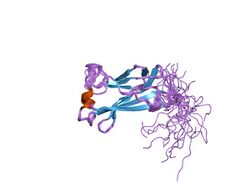Biology:MATH domain
| MATH | |||||||||
|---|---|---|---|---|---|---|---|---|---|
 solution structure of n-terminal domain of speckle-type poz protein | |||||||||
| Identifiers | |||||||||
| Symbol | MATH | ||||||||
| Pfam | PF00917 | ||||||||
| Pfam clan | CL0389 | ||||||||
| InterPro | IPR002083 | ||||||||
| SCOP2 | 1qsc / SCOPe / SUPFAM | ||||||||
| CDD | cd00121 | ||||||||
| |||||||||
The MATH domain, in molecular biology, is a binding domain that was defined originally by a region of homology between otherwise functionally unrelated domains, the intracellular TRAF-C domains of TRAF proteins and a C-terminal region of extracellular meprins A and B.
Although apparently functionally unrelated, intracellular TRAFs and extracellular meprins share a conserved region of about 180 residues, the meprin and TRAF homology (MATH) |domain.[1] Meprins are mammalian tissue-specific metalloendopeptidases of the astacin family implicated in developmental, normal and pathological processes by hydrolysing a variety of proteins. Various growth factors, cytokines, and extracellular matrix proteins are substrates for meprins. They are composed of five structural domains: an N-terminal endopeptidase domain, a MAM domain, a MATH domain, an EGF-like domain and a C-terminal transmembrane region. Meprin A and B form membrane bound homo-tetramers whereas homo-oligomers of meprin A are secreted. A proteolytic site adjacent to the MATH domain, only present in meprin A, allows the release of the protein from the membrane.[2]
TRAF proteins were first isolated through their ability to interact with TNF receptors.[3] They promote cell survival by the activation of downstream protein kinases and, ultimately, transcription factors of the NF-κB and AP-1 family. The TRAF proteins are composed of 3 structural domains: a RING finger in the N-terminal part of the protein, one to seven TRAF zinc fingers in the middle and the MATH domain in the C-terminal part.[1] The MATH domain is necessary and sufficient for self-association and receptor interaction. Through structural analysis, two consensus sequences recognised by the TRAF domain have been defined: a major one, [PSAT]x[QE]E and a minor one, PxQxxD.[4]
The structure of the TRAF2 protein reveals a trimeric self-association of the MATH domain.[5] The domain forms a new, light-stranded antiparallel beta sandwich structure. A coiled-coil region adjacent to the MATH domain is also important for the trimerisation. The oligomerisation is essential for establishing appropriate connections to form signalling complexes with TNF receptor-1. The ligand binding surface of TRAF proteins is located in beta-strands 6 and 7.[4]
MATH domains are found in a large number of Arabidopsis thaliana sequences, where they often lie alongside BTB/POZ domains, a structural domain that also promotes oligomerisation.[6]
References
- ↑ 1.0 1.1 "The new MATH: homology suggests shared binding surfaces in meprin tetramers and TRAF trimers". FEBS Lett. 530 (1–3): 1–3. October 2002. doi:10.1016/S0014-5793(02)03330-6. PMID 12387856.
- ↑ "COOH-terminal proteolytic processing of secreted and membrane forms of the alpha subunit of the metalloprotease meprin A. Requirement of the I domain for processing in the endoplasmic reticulum". J. Biol. Chem. 270 (10): 5449–56. March 1995. doi:10.1074/jbc.270.10.5449. PMID 7890660.
- ↑ "A novel family of putative signal transducers associated with the cytoplasmic domain of the 75 kDa tumor necrosis factor receptor". Cell 78 (4): 681–92. August 1994. doi:10.1016/0092-8674(94)90532-0. PMID 8069916.
- ↑ 4.0 4.1 "The structural basis for the recognition of diverse receptor sequences by TRAF2". Mol. Cell 4 (3): 321–30. September 1999. doi:10.1016/S1097-2765(00)80334-2. PMID 10518213.
- ↑ "Structural basis for self-association and receptor recognition of human TRAF2". Nature 398 (6727): 533–8. April 1999. doi:10.1038/19110. PMID 10206649.
- ↑ "Arabidopsis thaliana BTB/ POZ-MATH proteins interact with members of the ERF/AP2 transcription factor family.". FEBS J 276 (22): 6624–35. 2009. doi:10.1111/j.1742-4658.2009.07373.x. PMID 19843165.
External links
...
 |

